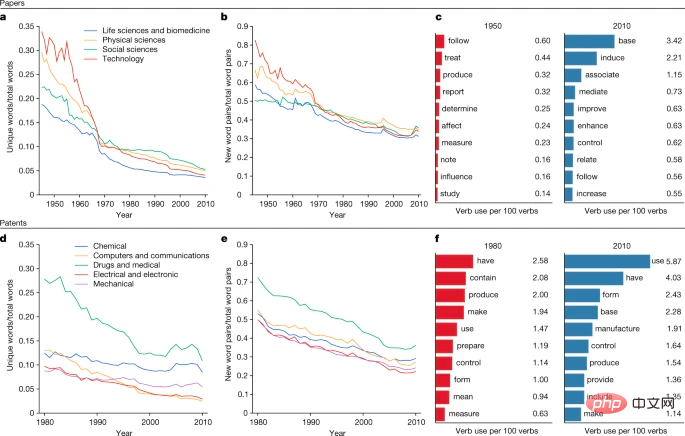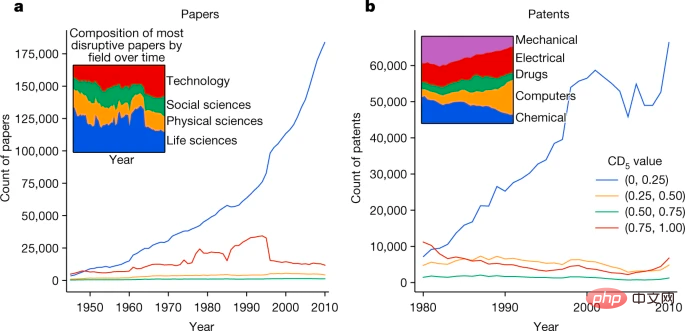
In the past few decades, the number of scientific and technological research papers published worldwide has increased dramatically. But based on an analysis of the papers and previous literature, scientists found that the "disruptiveness" of these papers was declining sharply.
Data from millions of manuscripts show that research completed in the 21st century is more of a "step-by-step" advance in science than it was in the mid-20th century. It’s not about charting a new direction and making previous work completely obsolete. An analysis of patents from 1976 to 2010 shows the same trend.
The report was published in the journal Nature on January 4. "These data suggest that something is changing," said Russell Funk, a sociologist at the University of Minnesota and co-author of the analysis. "The intensity of the disruptive discoveries that were there is no longer there."
Although the last century has witnessed an unprecedented expansion of scientific and technological knowledge, there are concerns that innovative activity is slowing down. Papers, patents, and even grant applications become less novel than previous work and less likely to connect different areas of knowledge. In addition, the gap between the year a Nobel Prize is discovered and the year it is awarded is growing, suggesting that some contributions are no longer as important as they once were.
This slowdown in innovation requires rigorous analysis and explanation. The report's authors reasoned that if a study was highly disruptive, subsequent studies would be less likely to cite references to that study and instead cite the study itself.
So the researchers analyzed 25 million papers (1945-2010) in the Web of Science (WoS) and 390 in the United States Patent and Trademark Office (USPTO) Patent Views database. million patents (1976-2010) to understand the creation of innovation gaps. WoS data includes 390 million citations, 25 million paper titles, and 13 million abstracts; Patents View data includes 35 million citations, 3.9 million patent titles, and 3.9 million abstracts. They then used the same analysis method on four additional datasets (JSTOR, American Physical Society Corpus, Microsoft Academic Graph, and PubMed) containing 20 million papers.
Using citation data from these 45 million manuscripts and 3.9 million patents, the researchers calculated an index to measure disruption, called the "CD index", with values ranging from - 1 to 1 distribution, from the least disruptive work to the most disruptive work.
The average CD index of research manuscripts fell by more than 90% from 1945 to 2010, and the average CD index of patents fell by more than 78% from 1980 to 2010. Disruption declines across all research fields and patent types analyzed, even after accounting for potential differences in factors such as citation conventions.
The authors also analyzed the most commonly used verbs in the manuscripts and found that studies from the 1950s were more likely to use meanings of creating or discovering terms such as "generate" or "determine," whereas studies in the 2010s were more likely to refer to incremental progress, using terms such as "improvement" or "enhancement."
"It's great that this phenomenon can be documented in such a detailed way," says Dashun Wang, a computational social scientist at Northwestern University in Evanston, Illinois. They used 100 Looking at this problem in different ways, I think it is generally very convincing."

From papers and patents The decline of disruptive science and technology can be seen in changes in language.
Other research shows that scientific innovation has also slowed in recent decades, said Yian Yin, a computational social scientist also at Northwestern University. But the study provides "a new starting point for studying how science changes in a data-driven way," he added.
Dashun Wang said that disruption itself is not necessarily a good thing, and at the same time, incremental science is not necessarily a bad thing. He also mentioned a situation: For example, the first direct observation of gravitational waves is both a revolutionary achievement and a product of incremental science.
The ideal situation is a healthy mix of incremental and disruptive research, says John Walsh, a technology policy expert at the Georgia Institute of Technology in Atlanta: "In a world where we care about the validity of research results, there's more replication. And reproduction can be a good thing."
What exactly caused the decline of disruption?
John Walsh says it's important to understand the reasons for this dramatic change, and part of it may stem from changes in the scientific enterprise. For example, there are many more researchers today than there were in the 1940s, creating a more competitive environment that raises the stakes of publishing research and pursuing patents. This in turn changes the incentives for researchers to do their work. For example, large research teams have become more common, and Dashun Wang and colleagues found that large teams are more likely to produce incremental rather than disruptive science.
John Walsh said it's not easy to find an explanation for the decline. While the overall proportion of disruptive research fell significantly between 1945 and 2010, the amount of highly disruptive research remained essentially the same.

Data show that the emergence of highly disruptive research is not inconsistent with the slowdown in innovation.
#At the same time, the rate of decline is puzzling. The CD index declined sharply from 1945 to 1970 and then even more significantly from the late 1990s to 2010.
"Whatever explanation you have for the decline in disruption, you need to explain its plateauing in the 2000s," he said.
The above is the detailed content of Nature issued an article: The speed of basic scientific innovation has slowed down and has entered the 'incremental era'. For more information, please follow other related articles on the PHP Chinese website!




